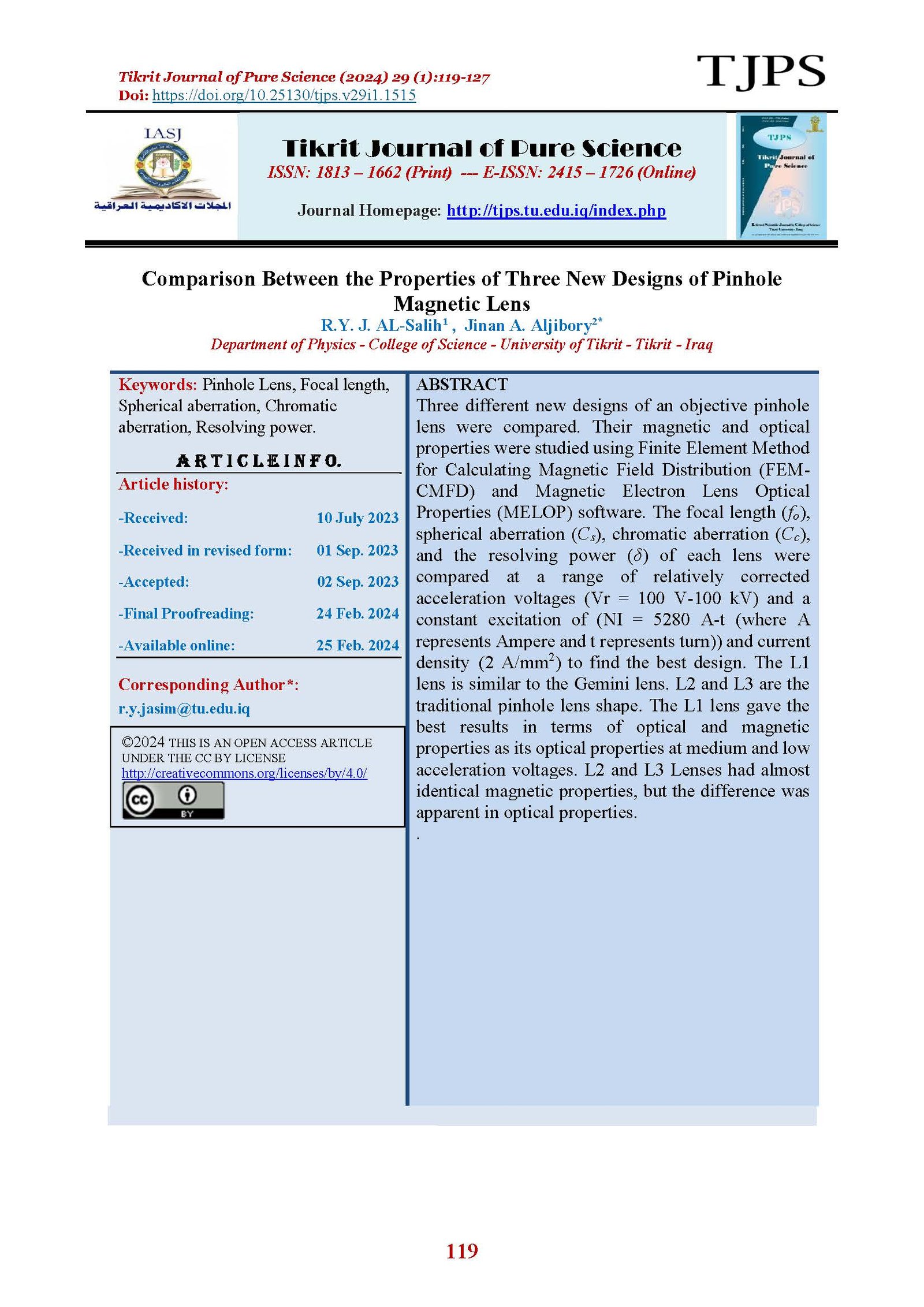Comparison Between the Properties of Three New Designs of Pinhole Magnetic Lens
Main Article Content
Abstract
Three different new designs of an objective pinhole lens were compared. Their magnetic and optical properties were studied using Finite Element Method for Calculating Magnetic Field Distribution (FEM-CMFD) and Magnetic Electron Lens Optical Properties (MELOP) software. The focal length (fo), spherical aberration (Cs), chromatic aberration (Cc), and the resolving power (δ) of each lens were compared at a range of relatively corrected acceleration voltages (Vr = 100 V-100 kV) and a constant excitation of (NI = 5280 A-t (where A represents Ampere and t represents turn)) and current density (2 A/mm2) to find the best design. The L1 lens is similar to the Gemini lens. L2 and L3 are the traditional pinhole lens shape. The L1 lens gave the best results in terms of optical and magnetic properties as its optical properties at medium and low acceleration voltages. L2 and L3 Lenses had almost identical magnetic properties, but the difference was apparent in optical properties.
Article Details

This work is licensed under a Creative Commons Attribution 4.0 International License.
Tikrit Journal of Pure Science is licensed under the Creative Commons Attribution 4.0 International License, which allows users to copy, create extracts, abstracts, and new works from the article, alter and revise the article, and make commercial use of the article (including reuse and/or resale of the article by commercial entities), provided the user gives appropriate credit (with a link to the formal publication through the relevant DOI), provides a link to the license, indicates if changes were made, and the licensor is not represented as endorsing the use made of the work. The authors hold the copyright for their published work on the Tikrit J. Pure Sci. website, while Tikrit J. Pure Sci. is responsible for appreciate citation of their work, which is released under CC-BY-4.0, enabling the unrestricted use, distribution, and reproduction of an article in any medium, provided that the original work is properly cited.
References
[1] AL-Janan, M.K., & AL-Salih, R.Y.J. (2023). Design and study the effect of inner bore diameter on the magnetic and optical properties of the unipolar lens. Baghdad Science Journal, 20(3):0805-0805. [2] Al-Khashab, M. A., & Al-Shamma, M. T. (2019). Improvement of the Optical Performance of the Geometrical Parameters of Snorkel Magnetic Lens. Rafidain journal of science, 28(1):85-97. [3] Al-Khashab, M.A., & Hujazie, N. S. (2011). The electron optical performance of the Gemini lens design for low voltage scanning electron microscopes. Dirasat, Pure Science, 38(1):52-60.
[4] Al-Salih, R.Y. (2018). The Influence of Bores Diameter on the SEM's Objective Lens Properties. Tikrit Journal of Pure Science, 23(2):107-113. [5] Edan, Z. H., & Abbas, T. M. (2023). Computer-aided design of free rotation and distortion doublet electromagnetic lenses. Materials Today: Proceedings, 80(7):2340-2346. [6] Hafsa Y.I., AL-Salih, R.Y.J. & Jasim, H.E. (2022). Effect of Outer Polepiece Shroud Geometry on Bipolar Lens and Studying its Properties. Tikrit Journal of Pure Science, 27(4):77-81. https://doi.org/10.25130/tjps.v27i4.38.
[7] AL-Janan, M.K., & AL-Salih, R.Y.J. (2022). Design and study the effect of Polepiece shape on the magnetic and optical properties of the unipolar lens. Tikrit Journal of Pure Science, 27(6):63-69. [8] Hawkes, P. W. (2013). Magnetic electron lenses. Springer Science & Business Media.
[9] Munro, E. (2011). Munro’s Electron Beam Software MEBS. Report, MEBS Ltd., London SW74AN, England.
[10] Lencová.B., Zlámal, J. (2008). A new program for the design of electron microscopes. Physics Procedia, 1(1):315-324.
[11] Salih, R.A., Abdulla, H.I.A., & Alkattan, E.M.A. (2022). Program for Calculating the Axial Magnetic Field Distribution of Magnetic Lenses Using Finite Element Method. International Journal of Computer Applications in Technology, 16(5):254-259.
[12] Salih, R.A., Abdullah, A.I.M., & Alkattan, E.M.A. (2021). Simple program for computing objective optical properties of magnetic lenses. International Journal of Computer Applications in Technology, 66(3):254-259.
[13] Al-Khashab, M.A., & Ahmed, A.A.H. (2004). Some approaches to the projector lens pole piece geometry and their effect on magnetic flux lines. Dirasat, Pure Sci, 31(1):22-29.
[14] Podbrdský, J. (1986). High current density magnetic electron lenses in modern electron microscopes. Scanning Electron Microscopy, 1986(3):887-896.
